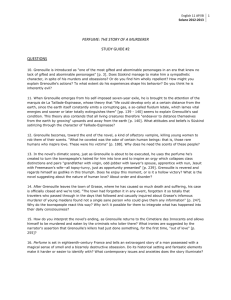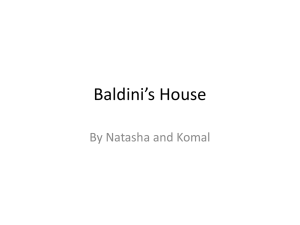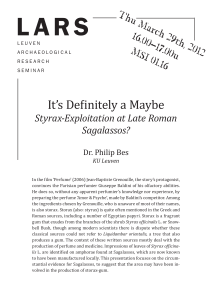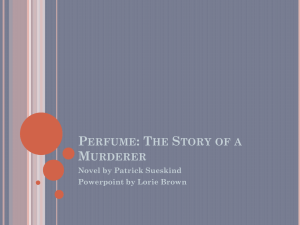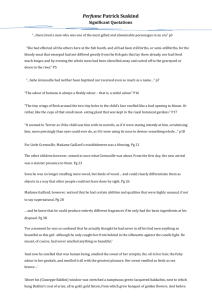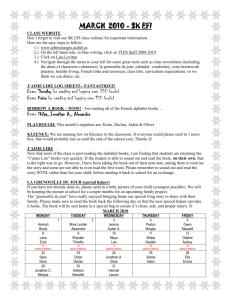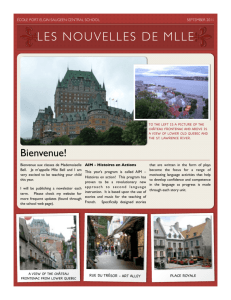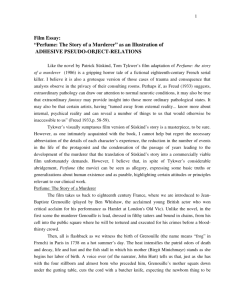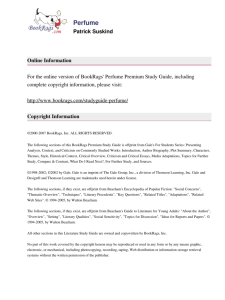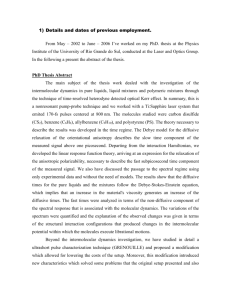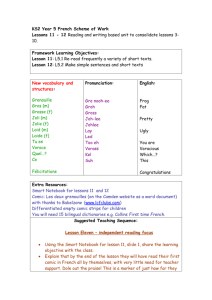Perfume - cisyeo
advertisement
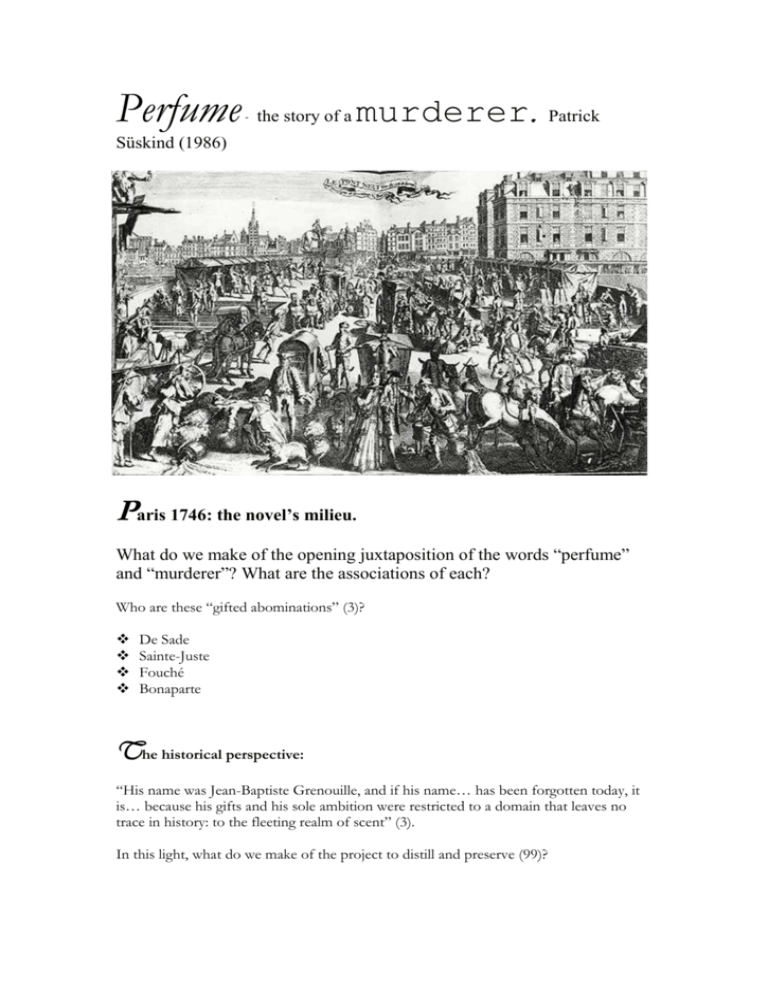
Perfume - the story of a murderer. Patrick Süskind (1986) Paris 1746: the novel’s milieu. What do we make of the opening juxtaposition of the words “perfume” and “murderer”? What are the associations of each? Who are these “gifted abominations” (3)? De Sade Sainte-Juste Fouché Bonaparte The historical perspective: “His name was Jean-Baptiste Grenouille, and if his name… has been forgotten today, it is… because his gifts and his sole ambition were restricted to a domain that leaves no trace in history: to the fleeting realm of scent” (3). In this light, what do we make of the project to distill and preserve (99)? Part 1 Chapter 1 4-6 Which images of humanity are proffered in the opening set piece? Chapter 2 10-11 What makes the infant Grenouille so horrifying? Chapter 3 17 What makes the theologian so ashamed? Chapter 4 20 What are the life-and-death hazards of eighteenth-century France, and to what level do they reduce the value of human life? 21 Why the “tick” imagery? Chapter 5 24 What do we make of Grenouille’s bodily response to scent? 25 Why does Grenouille prefer scent to language? Chapters 6-7 36-7 Grenouille as artist: what imagery is used to describe his compositions of scent? Chapter 8 39-44 The crime: artist, criminal, connoisseur, and the memory palace. Chapter 9 45-7 We now leave the world of teeming scents for the profusion of metropolitan consumer luxury items. Note the representation of Baldini and his shop. What are our impressions? Why might perfume be so crucial in this society? Chapter 10 48-51 What is Baldini’s attitude towards his profession? What has happened to him? What is the difference between an artist and a craftsman? Chapter 11 54 Note the emergence of the theft metaphor in descriptions of distillation. 55 How can we characterise the language used to describe Frangipani’s achievement? 55-58 What is Baldini’s attitude to the features which we recognise as Enlightenment values? Can we list these values? (eg speed, novelty, discovery…) Chapter 12 58-59 Look closely at the description of Baldini standing above the river. How does the river’s motion serve as an image of history? What is Baldini’s response to it? Chapter 15 81-82 Baldini watches Grenouille mixing Amor and Psyche. What sort of imagery is used to communicate his status as outsider? Which imagery is used to describe the power of perfume? 85-86 What does Baldini experience when he smells Grenouille’s creation: the new, improved Amor and Psyche? Chapter 16 87-88 Grenouille goes to bed. Note the re-emergence of the tick imagery. Of what does he dream? Chapter 17 90-93 Which imagery is used to describe Grenouille in these pages? Look at the exchange which takes place here between Baldini and Grenouille. What are the motives of each character? How can we describe this relationship? (Parasitic??) Chapter 18 93-94 Which techniques are used in this passage? What are their effects? 95 ff Which language is used to describe the process of distillation? 97-98 What “spellbinds” Grenouille about this process? Chapter 19 99-100 Grenouille’s attitude to distillation: what is his project? What frustrates him? Chapter 20 100 How is Grenouille’s suffering body described? 101 Note Baldini’s ambitions: what is the relationship between art and celebrity? 102-5 These pages are rich with many interesting issues: examine them carefully! Artistic theft/exploitation/parasitism/preying upon people and things; The body: corpse and sickness imagery; Distillation as a metaphor for extracting “soul”/secrets; Relationship between the physical and the mental: intellectual anxieties expressed physically; destruction and self-destruction; resurrection; preservation: keeping and returning; the preternatural; the supernatural. Chapter 21 106-8 In these pages two worlds are juxtaposed: How is the world of Baldini’s celebrity characterised? Which world is Grenouille entering, and what does he take with him? How does the imagery used to describe Grenouille confirm his alienation? Chapter 22 108-10 How does Baldini characterise his treatment of Grenouille? How does he justify it? Note that, as with Grimal’s death, Baldini perishes once Grenouille no longer has use for him. What is Grenouille? Part 2 Chapter 23 115 ff Note the transition from the teeming, multitudinous city to the countryside. How is Grenouille’s disgust for humanity conveyed? What is the seat of his misanthropy? How is his withdrawal from the human world conveyed in language? Chapter 24 120-1 What is Grenouille’s response to his solitude at the “magnetic pole” of “olfactory peace”? Chapter 25 121-3 In which ways is Grenouille’s lifestyle “unacceptable by bourgeois standards”? Which imagery is used to communicate his alienation? Chapter 26 124-5 What do you make of Grenouille’s “innermost universal theatre”? 126-7 What does the imagery used to figure the Empire of Grenouille the Great reveal of his self-conception and ambition? (The Creator?) Chapters 27 and 28: the memory palace (pp. 127-33) Read these important chapters carefully. Which metaphors are used to describe Grenouille’s experiences? How is the great world and its events contrasted with the “empire” within? How can you characterise Grenouille’s attitude to his physical needs? Chapter 29: the awakening 134, 6 What provokes Grenouille’s crisis of identity? 142-3 What do you make of the marquis’ interest in Grenouille’s physical state? 144 In what sort of language does the marquis couch his “achievement” in the transformation of Grenouille? What does this reveal about practitioners of the modern enlightenment? How is the marquis’ scientific faith satirised? How can we characterise Grenouille’s own power, which displaces it? 145 Note Grenouille’s alienation from the “figure” in the glass. What does this tell us about his attitude to humanity – even his own? Chapter 32: the impersonation 150-1 Grenouille’s perfume impersonates humanity. What is his initial attitude to it? 153-4 What is the effect of his perfume upon others? What is Grenouille’s attitude to others? 154-6 Note the language of Grenouille’s megalomaniacal fantasies. How does he express his challenge to God? Chapter 33: science triumphs? 158-9 In which terms does the marquis describe Grenouille’s transformation? What is the central irony of the events in this chapter? Part 3 Chapter 35 168 The merchants of Grasse: perfume equals power. 169-70 How does Grenouille describe this second significant perfume? Hat does it motivate him to do? Chapter 36 174-5 How are death and theft metaphors used to describe the manufacture of jonquil perfume? What is the effect of the juxtaposition of beauty and horror in this description? 177 The transformation of the jonquils from pomade to essence absolue. What sort of imagery is used to describe the way this substance is treated? Metaphors, anyone? Chapter 37 179-80 What language characterises the “death” of the tuberoses and jasmine? Chapter 38 183-4 Grenouille uses different scents to achieve different purposes. What functions do these perfumes serve? 184 How does Grenouille the artist amuse himself? 185 In which terms is the successful bottling of the puppy’s scent described? 187-8 A great set-piece: Grenouille hunts human prey. Which language is used to describe his experiments? Which humans’ scent does he seek? Chapter 39 189-91 Grenouille’s response to the girl’s scent: how does he describe her? 190-92 How does he respond to the idea of losing this scent? 193 How are the artist’s talents going to defeat time and loss? Chapter 40 194 How is Grenouille’s first victim described? 197 Why is the girls’ virginity even more horrifying than if they’d been ravished? Chapter 41 199-200 How is Richis’ daughter, Laure, described? 202 How close is Richis’ “profile” to the identity of the murderer? Chapter 45 214 How are Grenouille’s preparations for Laure’s death described? 218 How is Grenouille’s waiting described? 219 What is Grenouille’s attitude to Laure’s corpse? Why? Chapter 48 227 Grenouille is displayed: how does the crowd respond to the murderer? 228 What do you make of Grenouille’s sentence? What might be the purpose of this kind of punishment – the spectacle of suffering? 230-1 What kind of mood pervades execution day? Why? How does this occasion function within the community? Chapter 49 235 Which metaphor is used to describe this event? 236 ff How is Grenouille’s influence upon the crowd described? 239 Another set-piece: the orgy. Note: Language techniques; “human beasts”; language of disgust and contempt for humanity, juxtaposed with divine imagery; the experience figured by the fog. Chapter 50 245 How does the writer communicate the hangover from the orgy? 246 What do you make of th3 final paragraph of this chapter? Part 4 Chapter 51 251 What is Grenouille’s state of mind, and why? 252 Why does he reject his power? 253 What is significant about this setting? 254-5 What do you think about this method of suicide? What does it suggest about the nature of love? How does this accord with the treatment of love throughout the novel?
